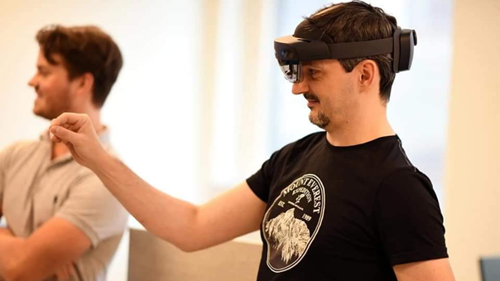Trust, less hierarchy and empowerment are keys to innovative organizations
-
Sist oppdatert
5. mai 2022
-
Kategori
-
Tema
- Innovation
- Organization
Trust serves as fuel for innovation is a new kind of oil which every nation has access to, writes David Coates and Kari Mette Solheim.
KNOWLEDGE @ KRISTIANIA: Innovation
Innovation has been key to Norway’s survival and prosperity. The climate, combined with a rugged landscape and short winter days and long summer nights creates a challenging environment to live and work in. These sometime chaotic conditions are a catalyst for Norwegian attitudes towards innovation, leadership, and teamwork. The following will attempt to shed some light on how and why innovation, led by appropriate leadership, has put Norway where it is today.
Equilibrium is not beneficial for change
As the popular Norwegian expression goes “There is no such thing as bad weather, only bad clothing”. It’s about changing your perspective without moving your feet.
But as in nature itself, sunny weather and calm seas are not the proponents for change nor growth. Equilibrium in nature can lead to stagnation and eventual extinction. Change promotes adaptation, transformation and growth. And we are all in need of that to survive and grow in these turbulent times.
50 per cent need reskilling by 2025
Upskilling and reskilling of employees is essential to meet the demands of the current work environment and equip us for future challenges. The pandemic has also highlighted the need for organizations to invest in digital transformation strategies.
How can a company best empower each individual in a hybrid working environment? A Harvard Business review article from 19. February 2019 states that 80 per cent of CEO`s believe that the need for new skills is the biggest business challenge.
According to the World Economic Forum's Future of Jobs Report from October 2020, Professor Klaus Schwab states that technological innovation can be leveraged to unleash human potential. 50 per cent of all employees will need reskilling by 2025, as the adoption of technology increases.
Today’s most valued skills
So what are the most valued skills today?
According to the World Economic Forum, 7 out of the 10 most important skills in 2025 will be:
- analytical thinking and innovation
- complex problem solving
- working with people; leadership and social influence
- technology use and development
- critical thinking and analysis
- creativity, originality and initiatives
But newly emerging the last years are skills in self-management such as active learning and learning strategies, resilience, stress tolerance and flexibility.
According to Grieg Seafood’s HR Director, Kathleen Mathiesen, the focus is now on new skills such as digital transformation and how organizations of teams are shifting the power balance. “Now we are transferring the power from leaders to the employees”.

Read also
New opportunities emerge from crises
In a 1959 speech, John F. Kennedy famously said: “When written in Chinese, the word ‘crisis’ is composed of two characters—one represents danger and the other represents opportunity”.
Throughout history, crises and extreme conditions have often forced individuals, countries, and even the whole world to find solutions - and from that, new opportunities. The environmental challenges facing the world now and Covid are examples of the dangerous threats driving change. Crises enable the collective adrenaline to flow, focusing minds on solving the problems at hand.
Norway’s BNP in June 2021 was back at the same level as before the Covid pandemic in February 2020 according to SSB-Statistics Norway. People and companies found new ways, with new technology, and new ways of working and collaborating all the while operating in sometimes unsustainable and chaotic home offices.
Lots of ideas… and time
We need innovation to overcome our challenges- and with that we mean with good ideas. But as Linus Pauling, winner of a Nobel prize in Chemistry and a Nobel Peace Prize once said- “To have good ideas you must have lots of ideas”. And to have good ideas you often need time.
Time to try out hunches and “connect the dots”. You have to experiment, test, learn, and try again (and probably fail a few times) in a safe environment. One company calls it “Google time” where the employees can use 20 per cent of their time to innovate, on what interests them. Products such as G-mail, Google maps, Twitter and Slack all owe their existence to allowing employees the time to have fun, try out ideas and to fail.
Less Control
And fueling these innovations is a new kind of oil which every nation has access to, if they choose to explore it, trust. Research by Professor Alexander Cappelen shows high levels of trust make economic growth easier. Productivity and value creation are higher than in countries with lower levels of trust. “If you wants enthusiasm, creativity, autonomy, and innovation research shows you must be in the green zone- lots of trust and ownership”.

The Agile Culture: Leading through Trust and Ownership. The Trust-Ownership Model. Figure: Polyanna Pixton
Leaders should give direction but at the same time give trust to their teams. Experts agree that autonomy is important for motivation and that visible management is essential. This is in line with our values, the Norwegian model, and the legacy of work life researcher Einar Thorsrud and his experiments in the 60s and 70s with industrial democracy, cooperation and self-governing groups and teams.
Dr. Karen Y. Wilson-Starks has studied toxic and control leadership and her research shows how this often causes a high turnover rate, a decline in productivity, less innovation, and interdepartmental conflict.

Read also
Servant leadership
One great Norwegian example of this trust is a consultancy company in Bergen, Miles. They talk about “reducing the BMI- the Bureaucracy Mass Index”. They have no budget, no KPI and no goals, but they have ambition. The man at the top, or rather the bottom, Tom Georg, calls himself a “servant leader” not the CEO or director. He serves his employees, focuses on trust instead of control management or giving orders. The employees decide when they want to buy a new phone or PC and they decide what skills they lack or conferences to attend. They do not need to ask their leader!
And this is partially responsible for their double margins (compared to their competitors). They are also one of Norway`s most innovative companies and 2nd best place to work among 1000 companies in Europe. But the most important message from Tom Georg is- “care about your employees”. As he say as the famous and shortest but most effective speech about leadership of Mother Teresa “Do you know your people… and do you love them?”.
So what is Innovation and Leadership?
Simply put, it has a lot to do with trust, less hierarchy and empowerment. Trust is the new oil and that is the fuel for innovation. Hierarchy and control slows development and power should be decentralized. Empowerment is the new leadership- lead your employees by serving them.
References:
- Bersin, Josh, og Marc Zao-Sanders. 2019. «Making Learning a Part of Everyday Work». Harvard Business Review
- World Economic Forum, October 2020. “The Future of jobs report 2020” October 2020.
- Pixton, Pollyanna, og Paul Gibson Nickolaisen, Niel. 2014. The Agile Culture: Leading through Trust and Ownership
- Treanor, Sarah. 2014. ‘How Norway Has Avoided the “Curse of Oil”’. BBC News, 27 August 2014, sec. Business.
Text: David Coates, Lecturer, School of Economics, Innovation and Technology and Kari Mette Solheim, Lecturer, School of Communication, Leadership and Marketing, both at Kristiania University College.
We love hearing from you:
Send your comments and questions regarding this article by E-mail to kunnskap@kristiania.no.
N

Consumers expect brands to take a stance on key issues
Managers cannot not take a stance on key issues. Consumers and other stakeholders increasingly expect brands to take a lead on sociopolitical issues.Les mer
Understanding the business opportunities of Extended Reality
Extended Reality (XR) is becoming an increasingly hot topic in research, business, and in our everyday lives.Les mer
N2

How blockchain technology can enhance trust in social business
Blockchain technology can be applied to enhance transparency and accountability in social business operations and thus lead to trust.Les mer
Researcher calls for a new, sustainable normal after the pandemic
Two sides of the same problem: social and environmental sustainability must be tackled as one, maintains researcher Beniamino Callegari.Les mer




